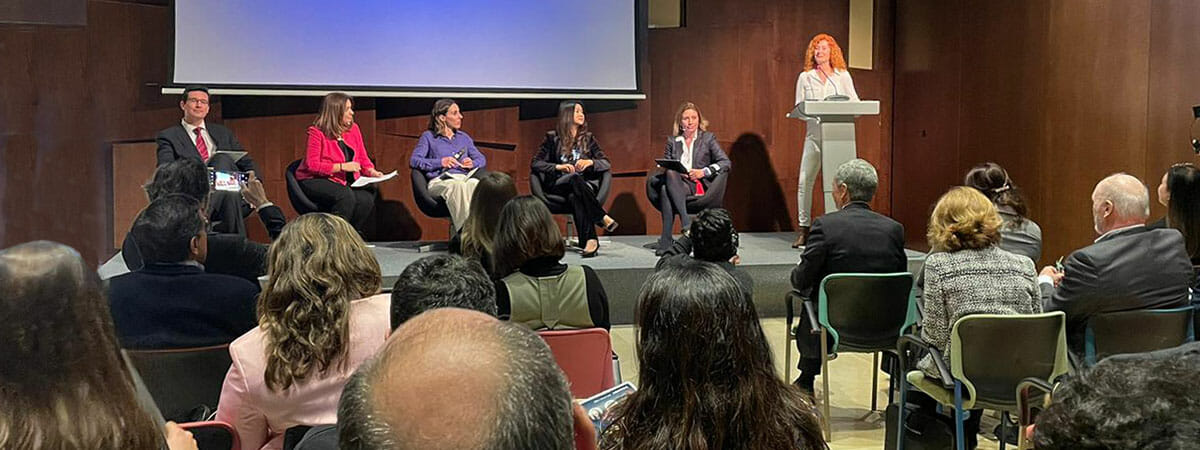As part of the TRANSFIERE Forum, the European Meeting on Science, Technology and Innovation held in Malaga in February 2023, an interesting round table was held on Advanced Air Mobility, organised by the Ellas Vuelan Alto (Women Fly High) association and AERTEC.
AAM will be safe, reliable and sustainable, and will soon become a reality thanks to the efforts of manufacturers, operators, regulators and infrastructure developers.
Future operators, experts in UAS operations, eVTOL manufacturers, airspace regulatory authorities and experts in vertiports and land infrastructure were all present at this round table, which painted a full picture of the challenges that are involved in bringing Advanced Air Mobility to our urban environments in the very short term.
Some of the main findings of the round table were:
There is a direct link between sustainability and AAM based on the realisation that eVTOL are electric, and thus do not consume fossil fuels or emit CO2 or other greenhouse gases into the atmosphere. Also noted was how the use of AAM to transport people and parcels could reduce the volume of global emissions by replacing part of the traditional (polluting) vehicles that are currently used to do this same task.
Among the related impacts considered was the topic of noise generated by EVTOL and the models that manufacturers are building to find solutions to minimise it. Given the urban environment in which this type of transport will be implemented, this is one of the unresolved issues, although it is worth noting that they are much quieter than helicopters or medium-sized road vehicles, which they will gradually replace to a certain extent.
AERTEC took part as a company with extensive experience in conceptualising and designing AAM infrastructure, having been involved in projects such as the ATLAS Experimental Centre, CEUS, Bluenest (Openvía Air) Whitepaper; R&D for vertiports in Hamburg, HERA Clean Aviation, etc.
Its proposal to classify vertiports based on their functionality – vertihubs, vertiports and vertistops – was very interesting, and underscored the importance of their location, of providing a high standard of service to passengers and of the profitability of this new mobility.
A key aspect in this context is the use of clean energy sources in vertiports for charging these vehicles. To this end, the discussion focused on the many airports that are already opting for renewable energy facilities (especially photovoltaic technology), airports that provide a benchmark when considering the feasibility of this option.
At the end, AERTEC brought up the challenges of the future, which involve obtaining reliable information in real time, including the quality of the communication signals, and redundancy, high-resolution maps, meteorology (no longer local, but specific), occupancy density, and possible FOD maps. In short, there is a need to advance the technologies that allow flying in confined spaces (multiple buildings) in a robust and safe manner.
Another challenge involves electric propulsion: develop efficient ways to store large amounts of energy (including in-situ hydrogen production), develop ultra-fast chargers and the possibility of swapping out the batteries in eVTOL aircraft.
Also in relation to this topic, the conviction was expressed that hydrogen will be the aviation fuel of the future, although challenges remain to be overcome, such as the complexity of producing, storing and distributing liquid H2. It will not be as simple as using fossil fuels, which are stable at room temperature and less reactive. Some existing infrastructure will become obsolete and new facilities will have to be developed to exist alongside those already present in airports.
The COO of EHang, a manufacturer of eVTOL vehicles, spoke about the progress made with its eVTOL models in various scenarios, as well as the plan to formally start passenger flights in China this year, and a short time later in the United States and the European Union (2024-2025). The challenge launched by the EHang representative referred to the initial reluctance of some regulatory entities to start out with unmanned autonomous vehicles, since they intend to issue permits in phases, first with a pilot and then without.
The official from CATEC explained that many tests are being conducted to ensure that the systems that control and manage the operations of these vehicles are safe and fully reliable before their operations are approved. In her opinion, manufacturers, operators and users need to realise that many flight hours are required and that the processes and stages set out by EASA have to be completed.
The Director of Operations at AGP for Aena, currently the largest airport operator in the world, noted that the airport operator has world-class policies on sustainability and technological development. In vertiports, they are collaborating with several manufacturers of eVTOLS and R&D programmes in order to study how to integrate vertiports into their airports. There are undoubtedly arguments for and against doing so airside or landside, so more progress will be needed in this area. They also fully realise that U-Space must be integrated into ATM without affecting the safety and regularity of “conventional” aircraft operations.

#uam

